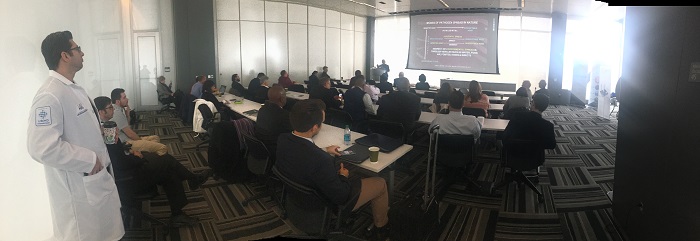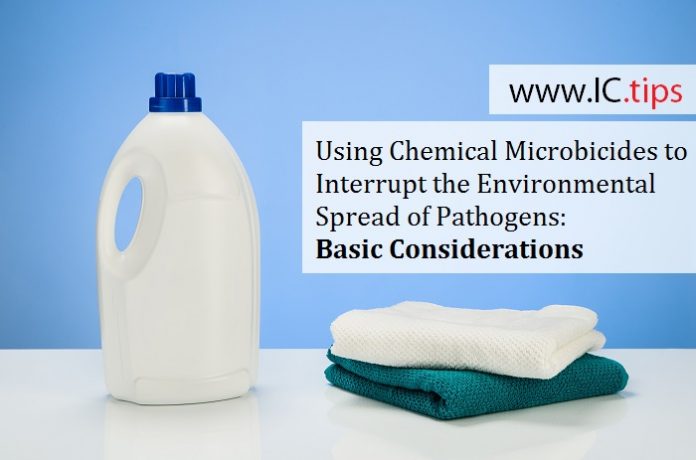Abstract
Environmental spread of dangerous pathogens is becoming more prevalent as international travel gets easier. Chemical microbicides are a useful tool to curb the spread of infectious diseases, but their efficacy is not often uniformly reported. This makes comparison of different disinfectants much more difficult and time consuming for purchasers of these products. At the March 30, 2017 showcase at our Center of Excellence for Infection Prevention and Control in Buffalo NY, Dr. Syed Sattar discussed the issues surrounding chemical microbicides, and the results of his efforts to improve consistency in testing and reporting of their effectiveness.
 Dr. Sattar addresses the COEIPAC showcase in Buffalo NY, on March 30, 2017
Dr. Sattar addresses the COEIPAC showcase in Buffalo NY, on March 30, 2017
(© InfectionControl.tips, 2017)
Main Article
The world is getting smaller with ever-faster and more frequent travel around the globe. That means that disease-causing agents can also hitch a ride on traveling humans and goods just as fast to turn localized infections into epidemics and pandemics within days. In addition to the spreading pathogens, antibiotic resistance can also travel just as fast. Bacteria with such resistance can spread the resistance to others like them and sometimes even cross the species barrier.
Unfortunately, infectious diseases in general are a mounting threat to our health due a unique combination of an ever-larger and aging population, burgeoning antibiotic resistance and changing life-styles. Though antibiotics and vaccines can be highly beneficial, but their numbers and accessibility remain limited. The rapid and inevitable development of resistance to antibiotics in bacteria has dampened the prospects of new drugs replacing the ones already rendered obsolete. These stark realities are forcing a revival of interest in safe and sustainable technologies to prevent the dissemination of infections within and across geographic boundaries. Among the crucial components of such a strategy are education for better public health along with targeted use of microbicidal chemicals for a cleaner environment in healthcare settings in particular.
In general, the direct person-to-person spread of pathogens is not amenable to infection prevention and control (IPAC) by the use of microbicidal chemicals. However, such chemicals can play an important role by reducing the spread of pathogens via environmental vehicles such as drinking water, food, air, fomites, medical devices and hands (Sattar, 2017). In effect, microbicidal chemicals constitute the backbone of infection prevention and control as long as they are selected and used properly. Sadly, the current reality is that certain of these chemicals may cause potential harm to humans as well as the environment while being ineffective as microbicides. Among the major issues here are the pre-market assessment of products and their label claims. Dr. Sattar has devoted much of his career to developing better methods for testing chemical microbicides. Several of his test protocols now form the basis for national and international standards to generate harmonized testing and label claims across international borders.
Resource utilization
Frequent decontamination of environmental surfaces in healthcare and other settings is neither necessary nor feasible. The main focus here should be on high-touch environmental surfaces (HITES), which are likely to harbour and donate pathogens during casual contact (Sattar, 2017). Their potential as environmental vehicles is influenced by not only the probability of pathogen contamination, but also by how well the contaminants may survive and possibly grow there along with the ease with which pathogens could be release on casual contact. As examples, Huslage et al (2010) identified HITES in patient rooms as bed rails, bed surfaces, supply carts, over-bed tables, and intravenous pumps.
Along with the identification of HITES for decontamination, it is important to also focus on pathogens with the greatest potential to spread through HITES. It is a significant but often unappreciated aspect of HITES decontamination that dangerous pathogens such as HIV do not survive well on HITES. Thus, the listing of such pathogens on product labels is based more on the ‘fear-factor’ than any scientific facts.
Wiping of HITES
Another important consideration in the decontamination of HITES is that it can be counter-productive by spreading localized pathogen contamination over a wider area by wiping with ineffective microbicidal chemicals. Further, environmental services staff, are often ill-trained and ill-equipped for their crucial role in IPAC, thus leading to a false sense of security and wastage of limited resources. Cursory and improper wiping of HITES, even when using an otherwise effective product is often the reason for failure in IPAC (Eckstein et al, 2007).
Disinfectant pre-soaked wipes are now being sold widely for their convenience and claims of effective environmental surface decontamination. However, their testing and label claims require much refinement and standardization for better consumer safety. It should be restated here that the incorporation of an ineffective disinfectant in a wipe can, in fact, spread localized contamination over a wider area during wiping. Dr. Sattar and his research team have addressed this concern by developing a device (The Wiperator) for testing such wipes for their potential for surface decontamination and also the ability to transfer the contamination to clean surfaces Sattar et al., 2015).
Use of Microbicides
‘Microbicides’ is a general term applied to chemicals that can kill microorganisms. Label claims of microbicides to be marketed require testing using standardized test protocols referenced by regulatory agencies. Here again, while the regulations for product registration before marketing are well-meaning, they are often outdated and the referenced protocols not reflective of the field use of microbicidal chemicals. Additionally, regulations for product testing and registration vary widely from one jurisdiction to another, thus making it expensive and time-consuming for manufacturers to develop and register products. However, it is encouraging to note that major international initiatives are now underway to address these concerns. For example, the Organization for Economic Cooperation and Development (OECD; Paris, France) is in the process of developing standardized and harmonized microbicide test protocols for use in all its 30+ industrialized member countries. The protocols being considered for this purpose are based on the ones developed by Dr. Sattar and his team.
Conclusion
In summary, microbicidal chemicals are a double-edged sword as no chemical that kill microbes can be totally safe for other life forms. Then, there are potential issues of materials compatibility. With this mind, every effort must be made to minimize the potential negative aspects of microbicidal chemicals while optimizing their desirable traits. This requires better awareness in infection preventionists and materials managers. At the same time, manufacturers must play their role in developing formulations which are innovative, safe as well as effective while using term ‘green’ more judiciously.
Regular and proper decontamination of HITES is essential for IPAC against healthcare-acquired infections (HAI). This aspect is ever-more crucial with the widening impact of antibiotic resistance, over-crowding of hospitals, cuts in budgets for environmental control with an increasing proportion of the aged and more vulnerable. In the face of this stark reality, there are no viable options at hand except to place greater emphasis on disease prevention strategies via IPAC. This will, of course, require a concerted effort on the part of researchers, government regulators, infection preventionists as well as the private sector.
References
Eckstein, B. C., Adams, D. A., Eckstein, E. C., Rao, A., Sethi, A. K., Yadavalli, G. K., & Donskey, C. J. (2007). Reduction of Clostridium difficile and vancomycin-resistant Enterococcus contamination of environmental surfaces after an intervention to improve cleaning methods. BMC infectious diseases, 7(1), 61.
Huslage, K., Rutala, W. A., Gergen, M. F., Sickbert-Bennett, E. E., & Weber, D. J. (2013). Microbial assessment of high-, medium-, and low-touch hospital room surfaces. Infection Control & Hospital Epidemiology, 34(02), 211-212.
Sattar SA (2017) Using Chemical Microbicides to Interrupt the Environmental Spread of Pathogens: Basic Considerations. COEIPAC Showcase 2017. March 30, 2017.
Sattar, S. A., Bradley, C., Kibbee, R., Wesgate, R., Wilkinson, M. A. C., Sharpe, T., & Maillard, J. Y. (2015). Disinfectant wipes are appropriate to control microbial bioburden from surfaces: use of a new ASTM standard test protocol to demonstrate efficacy. Journal of Hospital Infection, 91(4), 319-325.













Good point Andrew: The use of chemicals is a two edged sword. I would probably add the use of metals as well. Silver and copper have had some success as antimicrobial biostatics, yet leach into the environment. At Clean2Touch we decided against using either chemicals or metals for our products. Rather we chose a mechanical nanotechnology. Great topic! Thanks Andrew